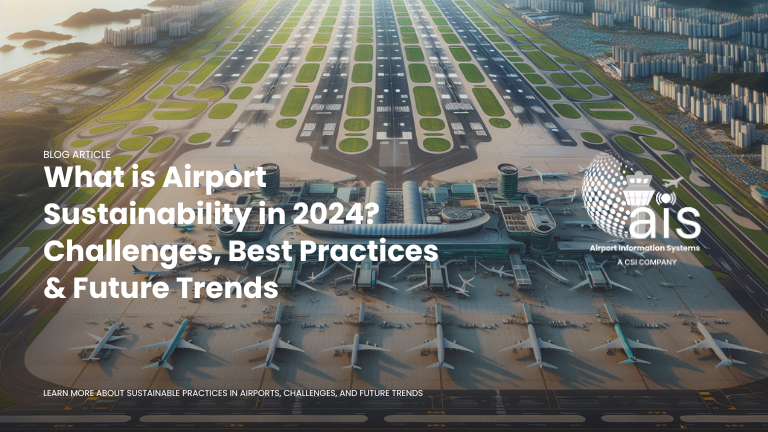- Introduction
- What is Green Revolution in Airports?
- Why Green Airports Matter in 2025?
- Green Airports Infrastructure
- Green Airports and Renewable Energy
- Waste Reduction Programs in Green Airports
- Sustainable Transportation for Passengers and Staff
- Digital Sustainable Infrastructure
- Government Support in Green Initiatives
- Barriers to Green Airports Implementations
- Conclusion (TL;DR)
- FAQs
Introduction
The increasing awareness of climate change and its impacts necessitates the shift to Green Airports. Airports are implementing innovative strategies to reduce their carbon footprint and promote eco-friendly practices. This movement, referred to as the “Green Revolution in Airports,” aims to create sustainable airport operations through energy efficiency, renewable resources, and reduction of waste.
At the 77th IATA Annual General Meeting on October 4, 2021, the aviation industry has set a collective goal of achieving net-zero carbon emissions by 2050, as endorsed by both the International Air Transport Association (IATA) and Airports Council International (ACI).
This blog is an informative guide to the ongoing green initiatives at various airports around the world while emphasising their importance within the broader context of environmental sustainability efforts in aviation.
What is Green Revolution in Airports?
The Green Revolution in Airports represents a comprehensive shift within the aviation sector. According to Airports Council International (ACI), a green airport is characterised by its commitment to sustainability through responsible energy use, effective waste management, and compliance with environmental regulations.
The Airport Carbon Accreditation program facilitates airports’ sustainability efforts by offering a structured framework for measuring and managing carbon emissions. It includes seven accreditation levels: Level 1: Mapping, Level 2: Reduction, Level 3: Optimisation, Level 3+: Neutrality, Level 4: Transformation, Level 4+: Transition, and Level 5: Net Zero.
The Green Airports transformation has contributed to international efforts in controlling climate change besides improving the operations of airports themselves.
Why Green Airports Matter in 2025?
The significance of Green Airports has increasingly become apparent as we move through 2025. Around 2-3% of global CO2 emissions are attributed to the aviation sector, which means airports have a huge role to play in reducing their contribution to this problem. This prompts airports to adopt sustainable measures, save emissions, operate efficiently, and go out of their way to attract green-conscious travelers.
Cochin International Airport in India is a prime example of this promise as the first fully solar-powered airport in the world, producing 29.5 megawatts of solar energy through more than 45 acres of solar panels. In addition, Passengers are increasingly attracted to eco-friendly airports that incorporate natural light, fresh air, and green spaces.
Initiatives like these demonstrate how Green Airports lead to both environmental benefits and improved passenger experiences.
The Role of Aviation in Sustainability
Airports rank as one of the largest emitting sources of greenhouse gas emissions globally. Their contribution towards sustainable developments would be one critical approach to minimising the impacts of climate change on society. One of the major strategies is the development and adoption of Sustainable Aviation Fuels (SAF). According to the International Air Transport Association (IATA), SAF could contribute about 65% of the emission reductions. SAF is much needed for aviation to achieve net-zero CO2 emissions by 2050. Besides, the Airport Fuel Management System efficiently supports the usage, storage, and dispensing of fuel at airports. This transition not only helps mitigate climate change but also supports economic growth in regions producing these fuels.
Shift Towards Green Airports
The shift towards Green Airports involves rethinking traditional airport operations and infrastructure design. Many airports are integrating sustainable principles into new constructions and renovations. For instance, under a sustainable fleet, London Luton will operationalise a 100% low-carbon fleet by 2030, with the projections cutting airport emissions by nearly 15%. This is part of a bigger scheme that involves working with industry partners to effect decarbonisation throughout all operational entities.
Green Airports Infrastructure
Energy-efficient buildings and smart technologies define green airports infrastructure. San Francisco International Airport (SFO) stands as an example for this. The airport aims to achieve net-zero carbon emissions by 2030. SFO’s Initiatives include the energy-efficient design of Harvey Milk Terminal 1, solar panel installations, rainwater harvesting systems, and a Zero Waste Plan with a goal of diverting more than 90% of waste from landfills. Investments in sustainable infrastructure will help airports strengthen their operational resilience while contributing positively to their communities.
Green Airports and Renewable Energy
Renewable energy adoption is one of the major components of the Green Revolution in airports. Airports are actively integrating solar, wind, and geothermal energy sources to power their operations. Bristol Airport has made significant strides by entering a 10-year Corporate Power Purchase Agreement (CPPA) with Luminous Energy. The substantial portion of its energy needs will be met through renewable sources generated by a solar farm in England. This will support Bristol Airport’s target to reach net-zero operations by 2030. This shift greatly reduces the need for fossil fuels and leads by example for other airports seeking a sustainable lifestyle.
Waste Reduction Programs in Green Airports
A reduction of waste is one of the most critical ways through which airports can achieve sustainability goals. Recycling programs, composting organic waste, and eliminating single-use plastics are spread across numerous facilities. For instance, Denver International Airport (DEN) launched its Zero Waste Valet program in June 2024, successfully diverting 69.2 tons of material from landfills into compost and recycling within its first six months of operation. Additionally, many airports are adopting single-stream recycling. This is allowing travelers to dispose of various recyclables in one bin, thereby increasing participation rates. This initiative not only reduces landfill contributions but also fosters a culture of sustainable living among passengers and employees.
Sustainable Transportation for Passengers and Staff
Many airports in the United Kingdom and around the world are developing efficient public transport links. Initiatives like carpooling are encouraging greener travel choices from passengers and employees. Amsterdam Schiphol Airport has established an extensive public transportation system that links passengers to a range of sustainable transit services, such as trains, buses, and electric taxis, making it more convenient for them to choose environmentally friendly transportation services. This integrated approach not only enhances accessibility but also reduces the carbon footprint of airport-related travel by a significant amount.
Electric and Hydrogen-Powered Ground Support Equipment (GSE)
Ground support equipment (GSE) based on electricity and hydrogen reduces emissions by a substantial amount compared with conventional diesel-based GSE, and is the biggest innovation so far in efforts to make an airport sustainable. Swissport, the largest aviation services company, had its fleet increase from 925 electric GSEs to 2,420 vehicles between 2016 and 2018. This fleet covers battery-powered aircraft pushback tractors and electric cargo loaders that together significantly reduce the airport’s carbon footprint. Electrification of GSE not only results in cleaner air quality but also improves operational efficiency at airports.
EV Transport for Passengers and Cargo
Airports are increasingly integrating electric vehicles into their transportation networks to reduce emissions and provide a quieter, more comfortable ride for travellers. Many airports have implemented electric shuttle services that connect terminals with parking lots, public transit stations, and hotels. At San Diego International Airport (SAN), electric shuttles are used to transport passengers between terminals and the airport’s rental car center, enhancing convenience while minimising environmental impact. This would encourage passengers to opt for eco-friendly transportation before flight or after their arrival.
Digital Sustainable Infrastructure
Sustainable digital infrastructure is an important aspect in optimising airport operations. Paperless operations and interconnected systems can enhance efficiency while reducing waste. Digital solutions such as e-tickets, mobile boarding passes, and automated check-in processes minimise paper usage and streamline passenger flow. Airport Information Systems’ ALDIS Aeronautical Billing engine automates key invoice management processes. ALDIS integrates with other airport systems to provide accurate calculations for landing fees, parking charges, and other aeronautical services. These innovations improve operational efficiency and contribute to a more sustainable travel experience.
Government Support in Green Initiatives
Government policies are major drivers in bringing about changes within the aviation sector. These policies promote the adoption of renewable energy sources, fund sustainable projects, and monitor regulatory framework. Further, the UK government has committed £9.2 million to airspace modernisation programs, which will be in the implementation of Free Route Airspace (FRA) to improve flight paths to reduce fuel consumption. The initiative will save 24,000 tonnes of CO2 every year. Coordinating government efforts with that of airport authorities can be key in developing an enabling environment for sustainable development.
Barriers to Green Airports Implementations
Even though the advantages of shifting to Green Airports are obvious, several challenges are encountered in the transition process. For instance, high upfront costs are a significant barrier to adopting green technologies. Change aversion is also a potential issue among the stakeholders, including airlines and local communities, who may be worried about disruption during the transition.
Additionally, significant energy consumption is a concern as airports require energy for essential operations like terminal lighting and ground transportation. Furthermore, urban development challenges can lead to land use and environmental issues, making it difficult to implement airport expansion plans.
To overcome these barriers, strategic planning, investment in research and development, and effective communication among all stakeholders are required to facilitate collaboration and propel progress toward sustainability goals.
Conclusion (TL;DR)
The Green Revolution in Airports represents a critical advancement in the aviation industry, focusing on sustainability and environmental responsibility. As we navigate through 2025, the importance of implementing eco-friendly practices in airport operations has never been more apparent. With the aviation sector contributing significantly to global CO2 emissions, airports are stepping up their efforts by adopting innovative strategies that include renewable energy sources, waste reduction programs, and sustainable infrastructure development.
Airports like Cochin International Airport and San Francisco International Airport exemplify this shift by integrating solar power and aiming for net-zero emissions. The adoption of Sustainable Aviation Fuels (SAF) and electric ground support equipment further underscores the industry’s commitment to reducing its carbon footprint. Additionally, effective government policies and community engagement are essential to overcoming barriers such as high initial costs and stakeholder resistance.
The bottom line would be that the collective force of airports, airlines, governments, and passengers would drive this green initiative forward. And by embracing sustainable practices, we can reshape air travel into a more environmentally friendly activity, ensuring the coming generations enjoy cleaner skies and healthier ecosystems.
Modernise Your Airport’s Digital Infrastructure!


